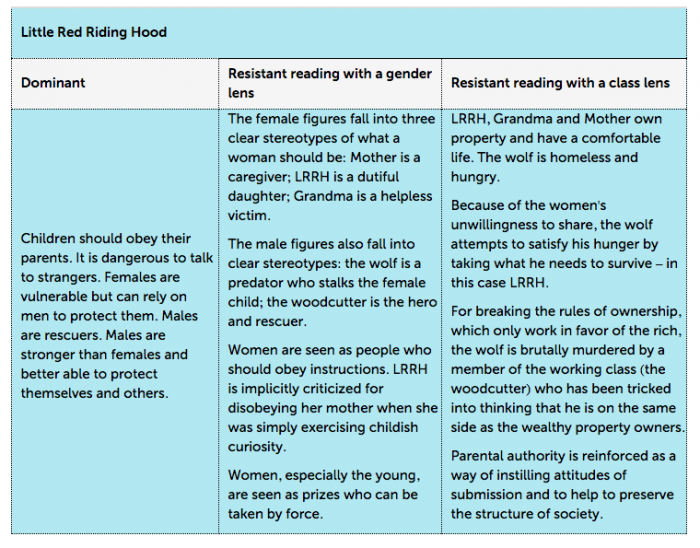What?
When?
Why?
Reading against the grain combines analysis, synthesis, evaluation and creation. It also develops and assesses comprehension as students must understand the text to successfully engage in an alternative reading.
How?
Choose a central text and plan initial readings.
- Assess students' understanding of the text. Resistant readings must come after students achieve foundational comprehension.This includes an understanding of the text’s central idea(s) and how these ideas develop over the course of the text. Require students to thoroughly cite textual evidence in order to demonstrate their understanding. A shared reading lesson that uses questions from Challenge the Text is a good way to lead up to reading against the grain.
- Familiarize students with three ways of interpreting texts:
- Dominant readings are the most common and widely-accepted interpretations of a text. They embody the dominant values and beliefs in a culture and position the reader to favor the interpretation.
- Alternative readings are any readings that differ from—but do not challenge—the commonly accepted interpretation. Alternative readings are less common but are easily accepted because they do not undermine the dominant reading.
- Resistant readings are alternative readings of the text that challenge dominant cultural beliefs and reject the position the text appears to offer. There are many different types of resistant reading. For instance, a feminist reading will focus on how a text reinforces stereotypes about the role of women.
- Illustrate the three interpretations. A familiar story like Cinderella works well for this modeling exercise. Remind students that while the resistant interpretations are clearly not how we were meant to read Cinderella, these alternatives make sense when the story is read closely.
- Have students determine the author’s point of view or purpose in the central text. In addition to describing the author’s view or purpose, students should use textual evidence to explain how the author advances her ideas or claims. This step sets up students to be successful in the next step by requiring them to engage with the dominant reading before considering other readings.
- Challenge students to produce alternative and resistant readings of the Perspectives central text. During initial modeling, choose the "lens" for reading based on the lesson objective and the textual themes. (Click here for a sample resistant reading through the lenses of gender and class.) Selecting the lens becomes more difficult as text complexity increases. Allow students to choose a lens that they find meaningful.
English language learners
Connection to anti-bias education
Sample A: Dominant and resistant readings of Cinderella
The dominant reading of Cinderella presents an ideal image of romantic love that survives against the odds. The prevailing message of this story encourages readers to believe that dreams can come true.
A resistant reading of Cinderella reveals the love interest to be a shallow man who judges women solely on the basis of physical attractiveness. A man who will marry a woman on the basis of a few hours of dancing is likely to leave Cinderella if someone with daintier feet comes along. The story also represents a woman's physical appearance as a commodity for her to use to gain social status and wealth. The prevailing message cautions readers against believing in romantic love.
A feminist reading of Cinderella sees the heroine as repressed and abused. To break free of this repression she is forced to enter into a world full of masculine power where she is appreciated for her ball gown and refinement. Further, her only hope to escape the shackles of domestic bondage relies on her ability to seduce and ensnare a man. The prevailing message points out the misogyny inherent in the societal structures surrounding Cinderella.
Sample B: Comparison of dominant and resistant readings of Little Red Riding Hood
